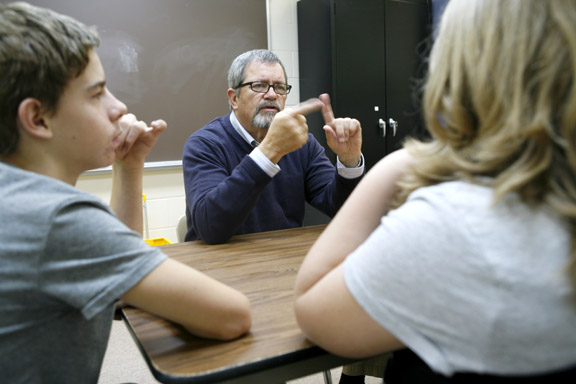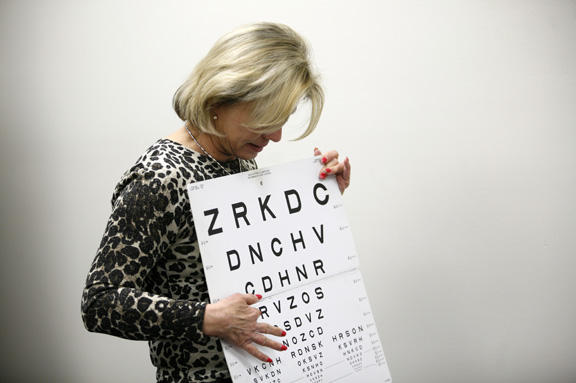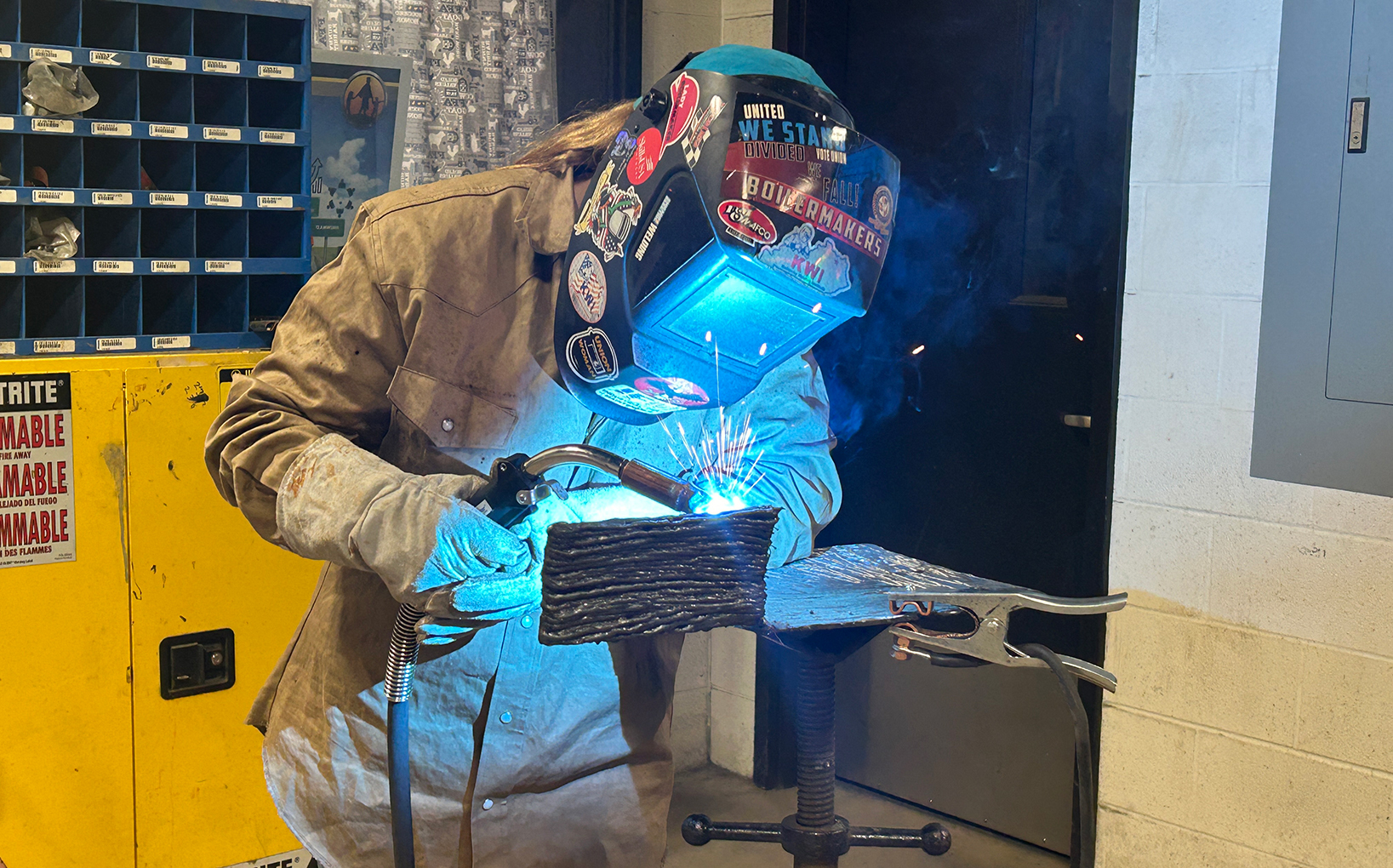
Kentucky School for the Deaf regional outreach consultant Andy Hensley signs with Green County Middle School 6th-grade students Allanah McBride and Riley Suratt Nov. 16, 2010. Photo by Amy Wallot
By Susan Riddell
susan.riddell@education.ky.gov
Even though the Kentucky schools for the blind and deaf, respectively, are centrally located in the state doesn’t mean that all students needing their services can attend.
And while most districts offer high-quality teachers capable of educating these students, sometimes they need more resources than those teachers can offer.
That’s when people like Betsy Flener and Andy Hensley can help.
Flener works for the Kentucky School for the Blind (KSB) and Hensley works for the Kentucky School for the Deaf (KSD). When called upon, they and a handful of other educators go to districts in their assigned region to fill in gaps – whether that’s working with students, teachers or both.
“They better understand the needs of the student,” said Leslie Glass, special education teacher at Butler County High School. Hensley, who has been with KSD for more than 24 years, works with Glass a handful of times during the school year, providing his knowledge and resources. He also is available for student observation when needed.
Hensley serves 30 districts that belong to the Caveland and River Region special education cooperatives. He said he will visit a school anywhere from one to 10 times a year, depending on numerous variables.
“Most are atypical, but every time I visit a program, they seem to be very grateful simply because I know and can articulate the difficulties they experience, then provide some direction to access resources and help them develop strategies,” Hensley said.
Flener has been an outreach consultant with KSB for six years and has more than 25 years’ experience in special education, including serving as a special education director and teacher. Based in Bowling Green, she also provides guidance for the Caveland and River Region special education cooperatives.
Flener is extremely helpful, according to Rick Boggess, who teaches visually impaired students in both Owensboro Independent and Daviess County school districts.
“She is always available to answer questions, help locate materials and provide direct assistance when asked to do so,” Boggess said. “Under her direction, there has been a large increase in the number of special materials available to teachers in the River Region and Caveland co-ops. Betsy has assisted with assessments, met with teachers to provide input, helped teachers and students learn adaptive technology, attended ARC (admissions and release committee) meetings, attended family events and more.”
Flener said a typical day varies according to the request of the district.
“If an evaluation is requested, then I would go to the district and observe the student, interview the parent and teacher, determine assistive technology needs, and provide information to the district as to where to obtain devices the student needs,” Flener said.
“Also, I would determine if the child needs a clinical low vision evaluation for optical devices and also determine what other needs the child has and if other agencies should be involved.”
Recently, Flener visited a teacher in the Green County school district who started using a functional Braille approach with an autistic student. Functional Braille is for students with limited reading ability who will use Braille mainly for labeling items and other simple tasks.
“With this approach, she has taught a child with a significant vision loss to read Braille,” Flener said. “I took (the teacher) some things she needed from our lending library. While there I had a discussion with her and her director regarding some current issues in our field. This teacher is going to be doing a presentation at the high school and requested the Zimmerman Low Vision Simulation Kit. It’s a kit that has glasses that actually simulate various eye conditions.”
Flener added that through various grants KSB has received the school has developed a “great lending library with lots of assistive technology. I think it has been a tremendous help to teachers.”
KSD and KSB each also provide support in other ways.

Kentucky School for the Blind regional outreach consultant Betsy Flener has Glasgow Middle School (Glasgow Ind.) 7th-grade student Eli Huff read from a distance during an assessment Nov. 15, 2010. Photo by Amy Wallot
“We’ve had numerous students who have participated in the Short Term Program (formerly the Short Course Program) at KSB,” Boggess said. “Under this program, students remain enrolled in their local districts while attending KSB for up to 12 weeks a year to receive more comprehensive assistance with skill development in areas such as Braille, adaptive technology, orientation and mobility, and daily living skills.
“For students who may not be able to attend the Short Term Program, KSB offers a weekend program for middle and high school students,” Boggess added. “These students have participated in the on-campus program as well as the job program. We’ve also referred some students to attend KSB full time.”
Glass said professional development offered by KSD has paid off. “Mr. Hensley has conducted a PD to inform teachers about needs of the students and help them understand what they hear on a daily basis,” Glass said. “Students with hearing impairments are attending more mainstreamed settings than before.”
Hensley said the need for districts is still growing even with support that’s available.
“It is clear that students and staff need resources and technical assistance,” Hensley said.
“Certified teachers of the deaf and hard of hearing and interpreters are in short supply, compounding difficulties district efforts to try and meet those needs, particularly in rural areas,” Hensley added. “Districts need additional knowledge of the impact of hearing loss on the development of the child, curricula needs of students and assistance in modifying instructional strategies and making environmental adaptations to meet student needs, and certainly help with the most critical elements: communication and social needs of those students.”
Flener agreed.
“Visual impairment is a very low-incidence handicap, and often when I receive a referral, it may be the first student with blindness with whom a teacher or district has worked, so they depend upon KSB for information and assistance,” Flener said.
Hensley said those interested in using KSB and KSD outreach need to know that getting help is easy. “It is available,” Hensley said. “They just need to contact the outreach consultant for their region through their co-op, KSD (or KSB).”
MORE INFO…
Betsy Flener, betsy.flener@ksb.kyschools.us, (270) 563-2113
Andy Hensley, andy.hensley@ksd.kyschools.us, (859) 239-7017
Meg Stone, meg.stone@ksb.kyschools.us, (502) 897-1583
Artie Grassman, artie.grassman@ksd.kyschools.us, (859) 239-7017









Leave A Comment